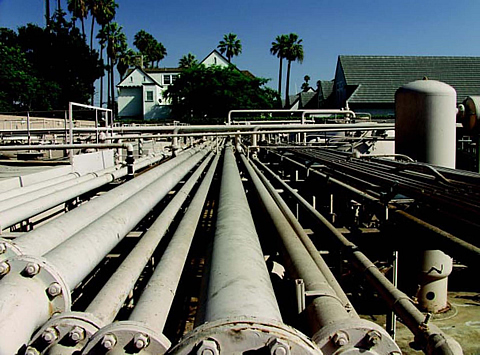The St. James lease in the Las Cienegas field is in an historic area of downtown Los Angeles, not far from Brea and the tar seeps that attracted early oil pioneers in California. Las Cienegas field is located approximately two miles from the Los Angeles, Civic Center. Production from this general area began in 1894. The downtown area continued to be drilled and developed with several small discoveries through the 1960s, when the Los Angeles Downtown and the Las Cienegas field were discovered. In the Las Cienegas area east of Beverly Hills, over 122 wells were drilled and the field became the only oil field with a street name-West Pico Boulevard. Several major operators developed portions of the field including: Atlantic Richfield (ARCO), Signal and Union Oil Company (Unocal), and Standard Oil of California (Chevron).
Unfortunately, high operating costs and low oil prices in the late 1990s caused wells in the St. James lease to be shut in. The Las Cienegas lease was acquired by St. James Oil from ARCO and Chevron who had jointly produced this portion of the field. St. James' experience indicated that wells in the Las Cienegas field which have been shut in for a long period of time often produce at rates 30 - 50% less than their pre-shut in rates when returned to production. In addition, these wells experience rapid scale build-up which results in severe production decline.
Project Results
The project has begun to stimulate five Las Cienegas wells, which have been shut in for four years. The project will attempt to restore production to pre-shut-in rates. Initial tests demonstrate that phosphonic acid/hydrochloric acid blend can be used to successfully stimulate the wells and increase production.
Benefits
The program design includes the use of a chemically modified hydrochloric acid combined with phosphonic acid. The phosphonic acid reacts with aluminum in clays and feldspars to form a temporary protective film, which then allows a deeper and more effective acid penetration. Phosphonic/hydrochloric acid treatment has the ability to inhibit the formation of calcium carbonate scale in the well and near well bore area.
Project Summary
Five Las Cienegas wells, all of which have a high tendency to form calcium carbonate scale, were selected for treating. These wells had been shut in for approximately four years. The intention of this project was to stimulate the wells and attempt to restore pre-shut in oil production rates. The program design includes the use of a chemically modified hydrochloric acid/phosphonic acid blend. The phosphonic acid in this formulation apparently reacts with aluminum in clays and feldspars to form a temporary protective film, which then allows a deeper acid penetration and more effective treatment. An important side benefit of the phosphonic acid is its ability to inhibit the formation of calcium carbonate scale in the well and near well bore area.
Work on the five wells was expected to be completed within one year of the project start. Unfortunately, work was delayed by metering and construction required by Southern California Gas (SCG), and a lack of a workover rig. Initial work on the selected wells has begun, with two wells acidized and prepared for returning to production. Three wells remain to be treated and returned to production.
In addition, in an unrelated action, St. James was also granted the competitive award of a Pump III project. This is a cooperative effort between DOE, the Interstate Oil and Gas Compact Commission (IOGCC), the California Oil Producer's Electricity Cooperative (COPE), the California Energy Commission (CEC) and the California South Coast Air Quality Management District (SCAQMD). This project involved the delivery to St. James and subsequent installation of three microturbines from the Los Angeles Department of Water and Power (LADWP), to settle overcharges to industrial power users that came about as a result of the recent California energy crisis.
The microturbine units were installed and are now operating, providing power to the St. James wells which are in the process of being returned to production.




